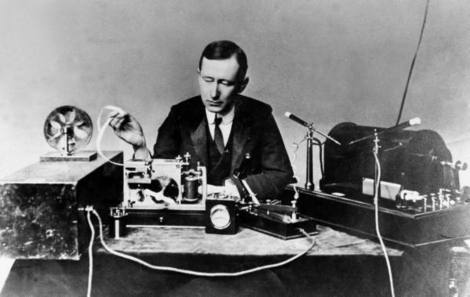Great entrepreneurs and innovators can teach us many lessons. Here are a few.
Experiment
On December 12, 1901, Guglielmo Marconi amazed the world when he sent and received the first wireless message across the Atlantic. The experts of the day believed that radio signals could only travel over a line-of-sight distance and that the curvature of the Earth would prevent the long distance use of radio.
Marconi started his famous experiment with the most powerful radio transmitter then built in Poldhu Cornwall. He set up a radio receiver in Newfoundland with an aerial consisting of 500 feet of wire supported by kites. They waited three days before the signal – a Morse Code S – was received.
The news that radio waves had crossed the Atlantic was sensational. How could it be possible? What the experts (and Marconi) did not know was that there was a charged layer around the Earth called the ionosphere which could reflect radio waves.
Within a year Marconi set up dependable radio communication with ships over 2,000 miles away. Eventually the Marconi Company linked the entire British Empire by radio.
Innovators do not trust experts
They do not trust theories, or models or spreadsheets. They trust real-life experiments. Marconi ignored all the authorities who declared that long distance radio signal transmission was impossible. He tried it and it worked.
Turn and face the strange
In 1954 the British government auctioned licences for commercial TV stations. These would be regional operations which could offer advertising on TV for the first time.
Various companies were interested in this opportunity and they naturally focussed on the regions with the best demographics.
Richer regions should generate more advertising revenue. Sidney Bernstein was the MD of a small cinema chain. He wanted to bid for a region but he decided not to bid for the richest region but instead to bid for the wettest region in the UK, the north-west of England.
He was successful and he established Granada Television based in Manchester and serving the north of England.
He surmised that if it was sunny outside people might be in their gardens or go for a walk. If it was pouring down with rain they were more likely to stay inside and watch television.
When everyone else is facing in one direction, deliberately look in another direction. The other companies bidding for franchises were asking, ‘Which is the wealthiest region?’ Bernstein asked, ‘Which is the wettest region?’
Ask childlike questions
Edwin Land was an American inventor who had studied Chemistry. In 1943 on holiday in Santa Fe he took a photograph of his three year old daughter, Jennifer. She asked why she could not see the result straight away and she kept asking why.
Land pondered this question and an idea formed in his mind. He went on to develop the Polaroid camera, a revolutionary product which sold over 150 million units and made Land into a celebrity. His daughter’s naive question had led him to challenge the assumptions that the whole photography industry took for granted.
Challenge assumptions by asking searching questions
When faced with a challenge we tend to ask one or two questions and then plunge into ideas and discussion. But by asking more questions, and more basic questions, we can discover insights that challenge our assumptions and allow us to reach deeper issues and better solutions. Edwin Land did this and went on to find a radically different and faster way to produce photographs.
Listen then act
When Anne Mulcahy was appointed CEO of Xerox Corp. in 2001, many people were surprised, including Mulcahy herself. She had never run a company before and had little financial experience, having worked mainly in Sales and Human Resources functions. Xerox faced huge financial problems and the stock price fell 15 per cent on news of her appointment.
She took over the reins of a company which was close to bankruptcy. Xerox had made losses for the previous six years and its debts amounted to over $17 billion. Its credit rating had been slashed.
Expenses were running out of control. The company was under investigation by the Securities and Exchange Commission for financial irregularities. Customers and shareholders were unhappy.
She started by talking and listening to employees and customers. She said, “When I became CEO, I spent the first 90 days on planes traveling to various offices and listening to anyone who had a perspective on what was wrong with the company. I think if you spend as much time listening as talking, that’s time well spent.”
The company’s turnaround was built on restructuring and the introduction of innovative products and services.
In 2008 Mulcahy was named ‘CEO of the Year’ by Chief Executive Magazine. In 2009 she retired from her position as CEO having accomplished what Money Magazine described as ‘the great turnaround story of the post-crash era.’
If you want to lead change you have to communicate your vision. Mulcahy devoted time to talking to people and listening. She painted a different and better future for the company and communicated it with a mock-up of a future Wall Street Journal article. She changed the culture and processes in a huge organisation with the power of communication and with clear and decisive actions.
This article is based on Paul Sloane’s latest book:
Think Like an Innovator – 76 inspiring lessons from the world’s greatest thinkers and innovators
Paul Sloane
Pearson £12.99
About Paul Sloane
Paul Sloane is the UK’s top leadership speaker on innovation and the founder of Destination Innovation. He is the author of over 20 books on lateral thinking and innovation which have sold over 2 million copies in total. He took a first in Engineering at Cambridge. He was a top Salesman with IBM and went on to be Managing Director at Ashton Tate and VP International for MathSoft. He has over 30,000 followers on Twitter and is well known as a blogger, speaker and workshop leader on the topics of creativity, lateral thinking and the leadership of innovation.







